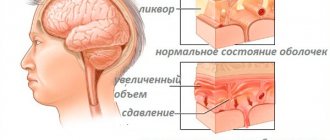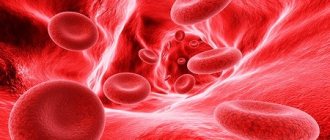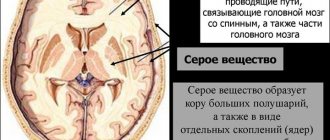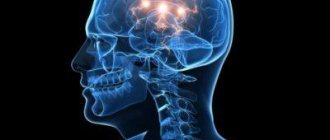Leukoaraiosis of the brain is a disease that is very rare. Accompanied by damage to the white matter. Changes and damage to the blood circulation in the brain appear. The changes become chronic. This is considered the main symptom that distinguishes the disease from others. For example: Alzheimer's disease, diabetes, stroke, encephalitis.
The disease can appear at any age because it is rare. It is more common in people over 30-40 years of age. The risk of developing cerebral leukoaraiosis is associated with an unhealthy lifestyle. Predisposing factors are smoking, alcoholism, drug addiction, and a sedentary lifestyle.
Causes of the disease
The disease is accompanied by the development of pathology within the white matter. It is a rare brain disease. The essence of the pathology is circulatory disorders and chronic ischemia. Leukoaraiosis can be a symptom of diseases such as stroke, hypertension, and Alzheimer's disease.
There are several factors and causes that provoke this disease. The main ones include:
- alcoholism, drug addiction;
- poor diet, prolonged fasting;
- sedentary lifestyle;
- elderly age;
- stroke (leukoaraiosis is a complication);
- any brain diseases (ischemia, vascular dementia);
- Alzheimer's disease (accompanied by dementia, as atrophic processes and age-related changes occur);
- diabetes mellitus (causes metabolic disorders in the body);
- Biswanger's disease;
- atrophy of the brain structure.
In each patient, the disease arises due to the individual characteristics of the body.
Symptoms of leukoaraiosis
Due to the fact that leukoariosis is not an independent disease, there are no individual symptoms unique to it. All signs will be associated with damage to the white matter of the brain. Disturbance in the functioning of the cortex and subcortex of the brain.
Major diseases also play a major role:
- Alzheimer's disease;
- stroke;
- diabetes;
- encephalopathy.
does not manifest itself for a long time . It is especially difficult to recognize if it is the only symptom of aging.
But as the disease progresses, symptoms such as:
- Emotional disorders are manifested by increased dysphoria and depression;
- Cognitive impairment – memory impairment, decreased thinking;
- There is a violation of speech and motor apparatus.
Stages of disease development
There are several types of leukoaraiosis:
- Periventicular leukoaraiosis . Around the anterior and posterior poles there are specific caps that surround them around the perimeter.
- Subcortical leukoariosis . There are many scattered or, on the contrary, merging lesions deep in the hemispheres.
The degrees of damage caused by leukoaraiosis are also divided:
First degree
Characteristic manifestations are observed: tinnitus, dizziness, headache, insomnia, increased fatigue, absent-mindedness, loss of coordination and concentration. The results of a medical examination can only indicate minor deviations in the form of active tendon reflexes, poor coordination, and decreased speed of movement, in particular, walking.
A reduction in stride length is often observed. Neuropsychological studies reveal discreet abnormalities in the subcutaneous parts of the brain. They take into account those responsible for concentration, memory, and perception of information. Thus, the research results are fully consistent with possible subjective symptoms
Second degree
At this stage, the patient's functional capabilities, which appeared in the first stage, deteriorate significantly. Clinical manifestations are quite clearly expressed. Patients complain of a sharp deterioration in memory, decreased motor skills, and a tendency to depression.
Along with this, problems associated with the genitourinary system may appear. This affects frequent urination, especially at night. The individuality of the organism in such cases retains the possibility of independently introducing life activity. Despite this, social and professional adaptation and brain performance are significantly reduced
Third degree
At this stage, leukoaraiosis progresses more rapidly. The signs of the second stage are significantly complicated. Coordination and fixation of movements suffers. Systematic falls, significant problems with urination, and urinary incontinence may occur .
Typically, cerebral leukoaraiosis is diagnosed at any stage using CT and MRI. The results of an MRI examination have certain features. Leukoaraiosis can be detected at an early stage. In this case, the research results will indicate different deviations. If the disease has serious, severe manifestations, then an MRI examination may indicate a slight deviation
Leukoaraiosis of the brain - what is it?
This disease causes damage to the white matter of the brain and disruption of the blood circulation in the brain. Leukoaraiosis is not a separate disease. This is one of the main symptoms of a number of abnormal changes in subcortical structures during diagnosis.
Important! Leukoaraiosis should not be classified as a vascular lesion of the brain.
This disease may be a sign of damage to the central nervous system of atrophic and other origins:
- Subcortical encephalopathy of an atherosclerotic nature or Binswanger's disease;
- Alzheimer's disease;
- Vascular dementia;
- Persistent hypertension
Changes in the brain at the morphological level in this disease are manifested in the following:
- Demyelination or destruction of the myelin sheath of neurons, leading to the destruction of the structure of white matter;
- The appearance of areas with incomplete necrosis. The boundaries are not clearly marked;
- Swelling of brain tissue;
- Extracellular spaces are enlarged.
A decrease in brain function occurs due to the expansion of the affected area.
With leukoaraiosis, two types of pathology are distinguished:
- periventricular;
- subcortical.
Periventricular leukoaraiosis of the brain - what is it?
This type of disease involves the placement of foci death in the form of a “cap” located above the ventricles, or in the form of a strip surrounding the lateral ventricles of the brain.
Area of leukoaraiosis in the brain
The types of disease depend on the location of the foci of atrophy.
The zone of leukoaraiosis is:
- around the lateral ventricles and their anterior horns;
- in the subcortical zone, the semioval center.
Clinical picture
Pervinintercular leukoaraiosis can manifest itself without characteristic symptoms. Clinical manifestations may not be observed for a long time. Signs occur if brain damage is long-lasting . This is also affected by the progression of the disease. The main symptoms include:
- defects, speech disorders;
- disturbance of emotional mood (frequent stress, tendency to depression, chronic form of dysphoria);
- significant memory impairment;
- intellectual abilities decrease.
Each affected person can independently detect characteristic changes. If the disease is detected in time, then within a short time, a person can cure it. Symptoms correspond to a certain stage of pervinticular leukoariasis.
It is worth noting that symptoms may manifest differently in each person. Only a doctor can diagnose the disease after certain diagnostics.
Diagnostic methods
To prescribe adequate and effective treatment, it is necessary to correctly diagnose the disease. The doctor prescribes the following examinations:
- examination by a neurologist;
- urine and blood analysis;
- MRI (magnetic resonance imaging);
- (CT scan);
- angiography (examination of the state of cerebral vessels using x-rays).
The brain is best diagnosed using MRI. This diagnosis helps to carefully examine all sections of the main brain and blood vessels. Helps detect various pathologies, disorders, changes (including bone tissue).
In addition, laboratory tests are prescribed: general blood and urine tests. Blood pressure is measured regularly. Doctors often diagnose leukoaraiosis in the hospital when the patient is being treated for other brain diseases.
Establishing diagnosis
If a patient is suspected of having structural changes in the white matter, he is referred for angiography. The X-ray technique evaluates the condition of blood vessels and the functioning of the central nervous system. If pathology is suspected, additional examinations are prescribed.
To diagnose the disease, a magnetic resonance imaging or computed tomography machine is used. The device shows manifestations in mild and moderate form.
Thanks to modern equipment, the doctor can also determine the presence of a severe clinical picture in the patient.
Drug therapy
Treatment is complex and consists of the use of vasoactive drugs. The main ones are: Eufillin, Vinpocetine. To block calcium channels, Nimodiine and Cinnarizine are prescribed. All drugs are suitable for combined use. Nicergoline is an adrenoreceptor blocker and is also used for leukoaraiosis. Each drug can be used strictly as prescribed by a doctor, and if there are no contraindications .
These medications have vasodilating properties. In addition, they produce a metabolic effect. They have a positive effect on lesions of leukoaraiosis. Use only when using neotropic therapy. Metabolic drugs are necessary to stimulate the corresponding processes in the body. These include the following medications: Oxiracetam, Pirecetam.
Treatment for leukoaraiosis can be very lengthy. It all depends on the degree of its development. The degree and occurrence of severe complications also depends on this. To reduce lesions, doctors prescribe Neotropil. Such drugs are the main ones in the treatment of this disease. Do not forget that self-medication is prohibited. This can cause serious consequences.
In practice, such therapy shows high effectiveness. Individual treatment is selected for each patient. Additionally, the neurologist will recommend completely changing your lifestyle during treatment:
- Treatment of leukoaraiosis will be successful if you engage in sports. Physical therapy is determined by the doctor. One of the best activities would be swimming.
- You can achieve good muscle tone with the help of a special massage.
- A person must completely give up bad habits.
- Healthy eating. Every day you need to eat foods high in vitamins, amino acids, and microelements.
The effectiveness of treatment for leukoaraiosis is determined by analyzing brain disorders in people of different ages. Mostly older people experience this disease . Research and study of drug therapy has been carried out for 20 years. Outcomes were assessed based on clinically significant changes. During the study, it was found that the effectiveness of treatment of leukoaraiosis is achieved by taking Nootropil.
Prevention
In modern medicine there are no drugs that can protect a person from leukorrhea or prevent its occurrence. The main rule for preventing this disease is a healthy lifestyle. A person must give up bad habits, play sports, and spend a long time in the fresh air.
Adequate nutrition is of great importance for the proper functioning of the brain. Every day with food, a person should receive the required amount of vitamins, microelements and nutrients. This is the key to human health. In addition, prevention depends on timely diagnosis and treatment of vascular diseases . Since such disorders occur in old age, special attention should be paid to health.
The following foods and nutrients will help reduce the risk of developing brain diseases: garlic, ginger, pomegranate, turmeric, omega-3, B vitamins, folic acid, carrots, beets, walnuts.
Don’t forget to drink the required amount of water per day. This factor is very important in the functionality of the body. If you follow all the rules, you can significantly reduce the risk of developing leukoaraiosis. In old age, people should undergo routine examination of blood vessels and heart. If pathology is detected in time, stroke and other serious diseases can be avoided.
Forecast
The prognosis for leukoaraiosis is not accurate. It would seem that by diagnosing in time and prescribing treatment, there is a chance to stop the development of white matter thinning and delay the moment of cessation of brain function. However, the process of dementia cannot be avoided, so patients need regular monitoring and observation.
As a result of dementia, the risk of becoming disabled increases. This or that group is determined by the degree of disability and how much a person needs help.
Prevention of the development of brain dysfunction involves maintaining a healthy lifestyle, treating primary pathologies, and taking a course of nootropic medications. On top of that, the patient should continue to be monitored by a neurologist, particularly in old age.











